The Human Stain by Philip Roth - PDF
VerifiedAdded on 2021/06/16
|5
|1447
|134
AI Summary
Contribute Materials
Your contribution can guide someone’s learning journey. Share your
documents today.
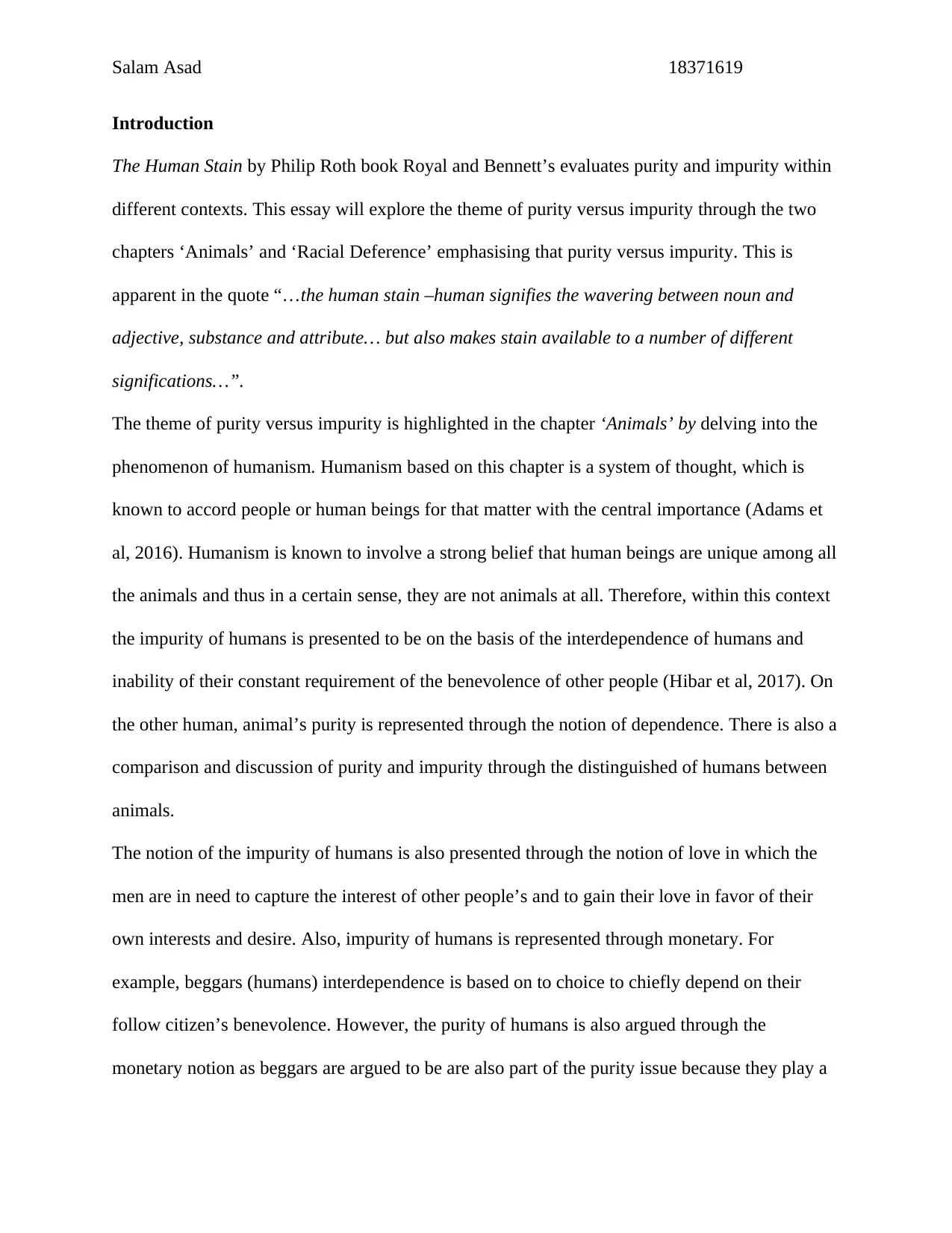
Salam Asad 18371619
Introduction
The Human Stain by Philip Roth book Royal and Bennett’s evaluates purity and impurity within
different contexts. This essay will explore the theme of purity versus impurity through the two
chapters ‘Animals’ and ‘Racial Deference’ emphasising that purity versus impurity. This is
apparent in the quote “…the human stain –human signifies the wavering between noun and
adjective, substance and attribute… but also makes stain available to a number of different
significations…”.
The theme of purity versus impurity is highlighted in the chapter ‘Animals’ by delving into the
phenomenon of humanism. Humanism based on this chapter is a system of thought, which is
known to accord people or human beings for that matter with the central importance (Adams et
al, 2016). Humanism is known to involve a strong belief that human beings are unique among all
the animals and thus in a certain sense, they are not animals at all. Therefore, within this context
the impurity of humans is presented to be on the basis of the interdependence of humans and
inability of their constant requirement of the benevolence of other people (Hibar et al, 2017). On
the other human, animal’s purity is represented through the notion of dependence. There is also a
comparison and discussion of purity and impurity through the distinguished of humans between
animals.
The notion of the impurity of humans is also presented through the notion of love in which the
men are in need to capture the interest of other people’s and to gain their love in favor of their
own interests and desire. Also, impurity of humans is represented through monetary. For
example, beggars (humans) interdependence is based on to choice to chiefly depend on their
follow citizen’s benevolence. However, the purity of humans is also argued through the
monetary notion as beggars are argued to be are also part of the purity issue because they play a
Introduction
The Human Stain by Philip Roth book Royal and Bennett’s evaluates purity and impurity within
different contexts. This essay will explore the theme of purity versus impurity through the two
chapters ‘Animals’ and ‘Racial Deference’ emphasising that purity versus impurity. This is
apparent in the quote “…the human stain –human signifies the wavering between noun and
adjective, substance and attribute… but also makes stain available to a number of different
significations…”.
The theme of purity versus impurity is highlighted in the chapter ‘Animals’ by delving into the
phenomenon of humanism. Humanism based on this chapter is a system of thought, which is
known to accord people or human beings for that matter with the central importance (Adams et
al, 2016). Humanism is known to involve a strong belief that human beings are unique among all
the animals and thus in a certain sense, they are not animals at all. Therefore, within this context
the impurity of humans is presented to be on the basis of the interdependence of humans and
inability of their constant requirement of the benevolence of other people (Hibar et al, 2017). On
the other human, animal’s purity is represented through the notion of dependence. There is also a
comparison and discussion of purity and impurity through the distinguished of humans between
animals.
The notion of the impurity of humans is also presented through the notion of love in which the
men are in need to capture the interest of other people’s and to gain their love in favor of their
own interests and desire. Also, impurity of humans is represented through monetary. For
example, beggars (humans) interdependence is based on to choice to chiefly depend on their
follow citizen’s benevolence. However, the purity of humans is also argued through the
monetary notion as beggars are argued to be are also part of the purity issue because they play a
Secure Best Marks with AI Grader
Need help grading? Try our AI Grader for instant feedback on your assignments.
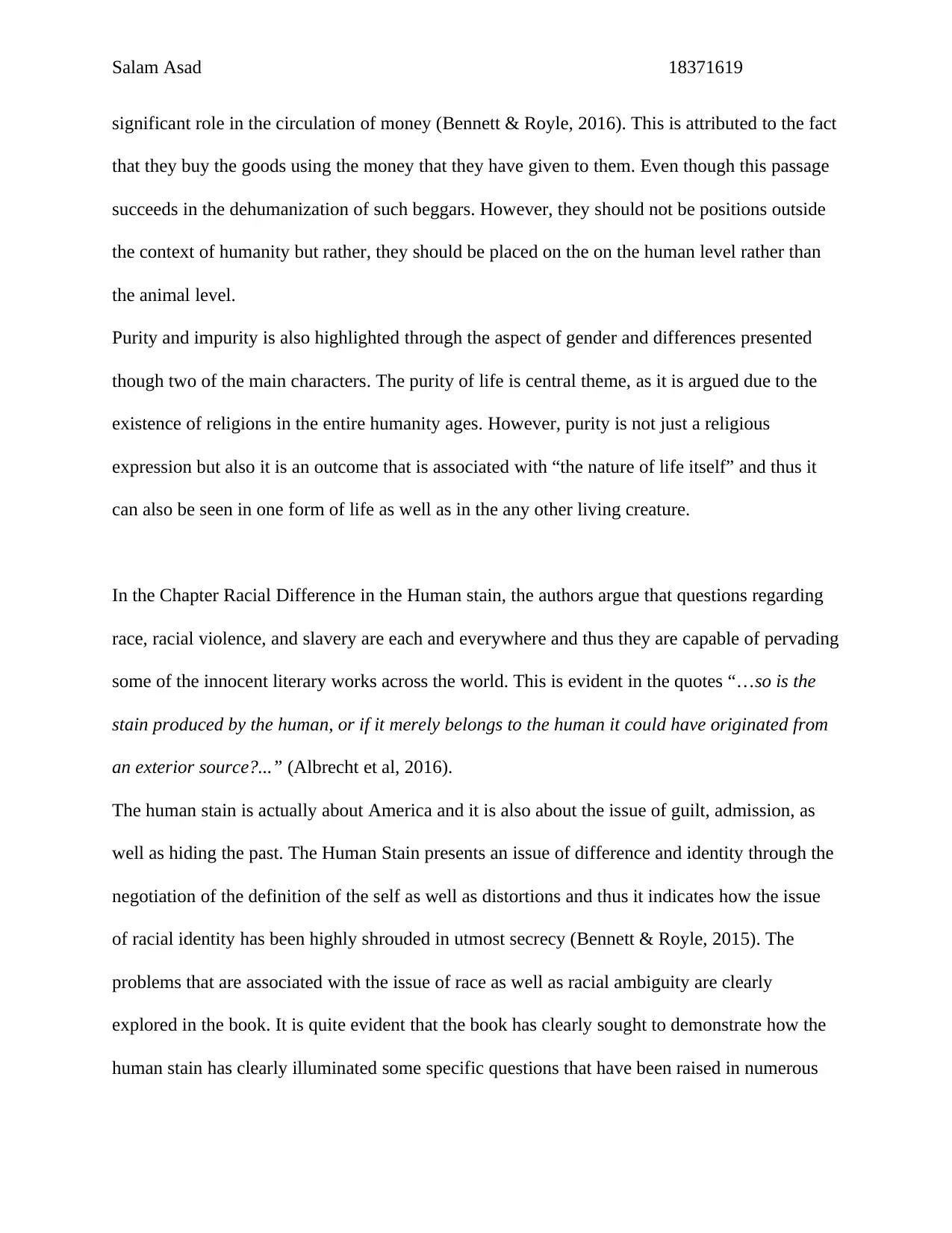
Salam Asad 18371619
significant role in the circulation of money (Bennett & Royle, 2016). This is attributed to the fact
that they buy the goods using the money that they have given to them. Even though this passage
succeeds in the dehumanization of such beggars. However, they should not be positions outside
the context of humanity but rather, they should be placed on the on the human level rather than
the animal level.
Purity and impurity is also highlighted through the aspect of gender and differences presented
though two of the main characters. The purity of life is central theme, as it is argued due to the
existence of religions in the entire humanity ages. However, purity is not just a religious
expression but also it is an outcome that is associated with “the nature of life itself” and thus it
can also be seen in one form of life as well as in the any other living creature.
In the Chapter Racial Difference in the Human stain, the authors argue that questions regarding
race, racial violence, and slavery are each and everywhere and thus they are capable of pervading
some of the innocent literary works across the world. This is evident in the quotes “…so is the
stain produced by the human, or if it merely belongs to the human it could have originated from
an exterior source?...” (Albrecht et al, 2016).
The human stain is actually about America and it is also about the issue of guilt, admission, as
well as hiding the past. The Human Stain presents an issue of difference and identity through the
negotiation of the definition of the self as well as distortions and thus it indicates how the issue
of racial identity has been highly shrouded in utmost secrecy (Bennett & Royle, 2015). The
problems that are associated with the issue of race as well as racial ambiguity are clearly
explored in the book. It is quite evident that the book has clearly sought to demonstrate how the
human stain has clearly illuminated some specific questions that have been raised in numerous
significant role in the circulation of money (Bennett & Royle, 2016). This is attributed to the fact
that they buy the goods using the money that they have given to them. Even though this passage
succeeds in the dehumanization of such beggars. However, they should not be positions outside
the context of humanity but rather, they should be placed on the on the human level rather than
the animal level.
Purity and impurity is also highlighted through the aspect of gender and differences presented
though two of the main characters. The purity of life is central theme, as it is argued due to the
existence of religions in the entire humanity ages. However, purity is not just a religious
expression but also it is an outcome that is associated with “the nature of life itself” and thus it
can also be seen in one form of life as well as in the any other living creature.
In the Chapter Racial Difference in the Human stain, the authors argue that questions regarding
race, racial violence, and slavery are each and everywhere and thus they are capable of pervading
some of the innocent literary works across the world. This is evident in the quotes “…so is the
stain produced by the human, or if it merely belongs to the human it could have originated from
an exterior source?...” (Albrecht et al, 2016).
The human stain is actually about America and it is also about the issue of guilt, admission, as
well as hiding the past. The Human Stain presents an issue of difference and identity through the
negotiation of the definition of the self as well as distortions and thus it indicates how the issue
of racial identity has been highly shrouded in utmost secrecy (Bennett & Royle, 2015). The
problems that are associated with the issue of race as well as racial ambiguity are clearly
explored in the book. It is quite evident that the book has clearly sought to demonstrate how the
human stain has clearly illuminated some specific questions that have been raised in numerous
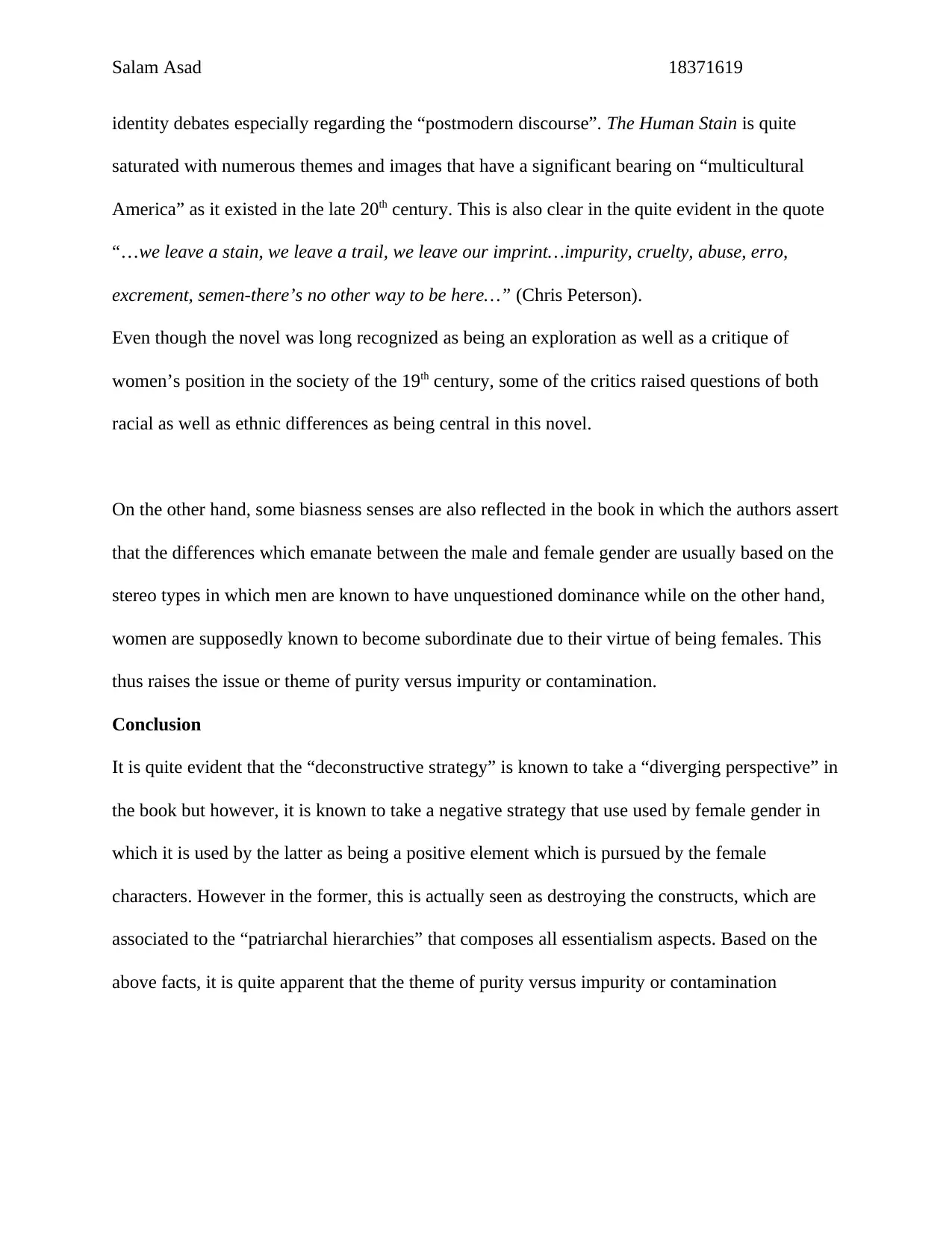
Salam Asad 18371619
identity debates especially regarding the “postmodern discourse”. The Human Stain is quite
saturated with numerous themes and images that have a significant bearing on “multicultural
America” as it existed in the late 20th century. This is also clear in the quite evident in the quote
“…we leave a stain, we leave a trail, we leave our imprint…impurity, cruelty, abuse, erro,
excrement, semen-there’s no other way to be here…” (Chris Peterson).
Even though the novel was long recognized as being an exploration as well as a critique of
women’s position in the society of the 19th century, some of the critics raised questions of both
racial as well as ethnic differences as being central in this novel.
On the other hand, some biasness senses are also reflected in the book in which the authors assert
that the differences which emanate between the male and female gender are usually based on the
stereo types in which men are known to have unquestioned dominance while on the other hand,
women are supposedly known to become subordinate due to their virtue of being females. This
thus raises the issue or theme of purity versus impurity or contamination.
Conclusion
It is quite evident that the “deconstructive strategy” is known to take a “diverging perspective” in
the book but however, it is known to take a negative strategy that use used by female gender in
which it is used by the latter as being a positive element which is pursued by the female
characters. However in the former, this is actually seen as destroying the constructs, which are
associated to the “patriarchal hierarchies” that composes all essentialism aspects. Based on the
above facts, it is quite apparent that the theme of purity versus impurity or contamination
identity debates especially regarding the “postmodern discourse”. The Human Stain is quite
saturated with numerous themes and images that have a significant bearing on “multicultural
America” as it existed in the late 20th century. This is also clear in the quite evident in the quote
“…we leave a stain, we leave a trail, we leave our imprint…impurity, cruelty, abuse, erro,
excrement, semen-there’s no other way to be here…” (Chris Peterson).
Even though the novel was long recognized as being an exploration as well as a critique of
women’s position in the society of the 19th century, some of the critics raised questions of both
racial as well as ethnic differences as being central in this novel.
On the other hand, some biasness senses are also reflected in the book in which the authors assert
that the differences which emanate between the male and female gender are usually based on the
stereo types in which men are known to have unquestioned dominance while on the other hand,
women are supposedly known to become subordinate due to their virtue of being females. This
thus raises the issue or theme of purity versus impurity or contamination.
Conclusion
It is quite evident that the “deconstructive strategy” is known to take a “diverging perspective” in
the book but however, it is known to take a negative strategy that use used by female gender in
which it is used by the latter as being a positive element which is pursued by the female
characters. However in the former, this is actually seen as destroying the constructs, which are
associated to the “patriarchal hierarchies” that composes all essentialism aspects. Based on the
above facts, it is quite apparent that the theme of purity versus impurity or contamination
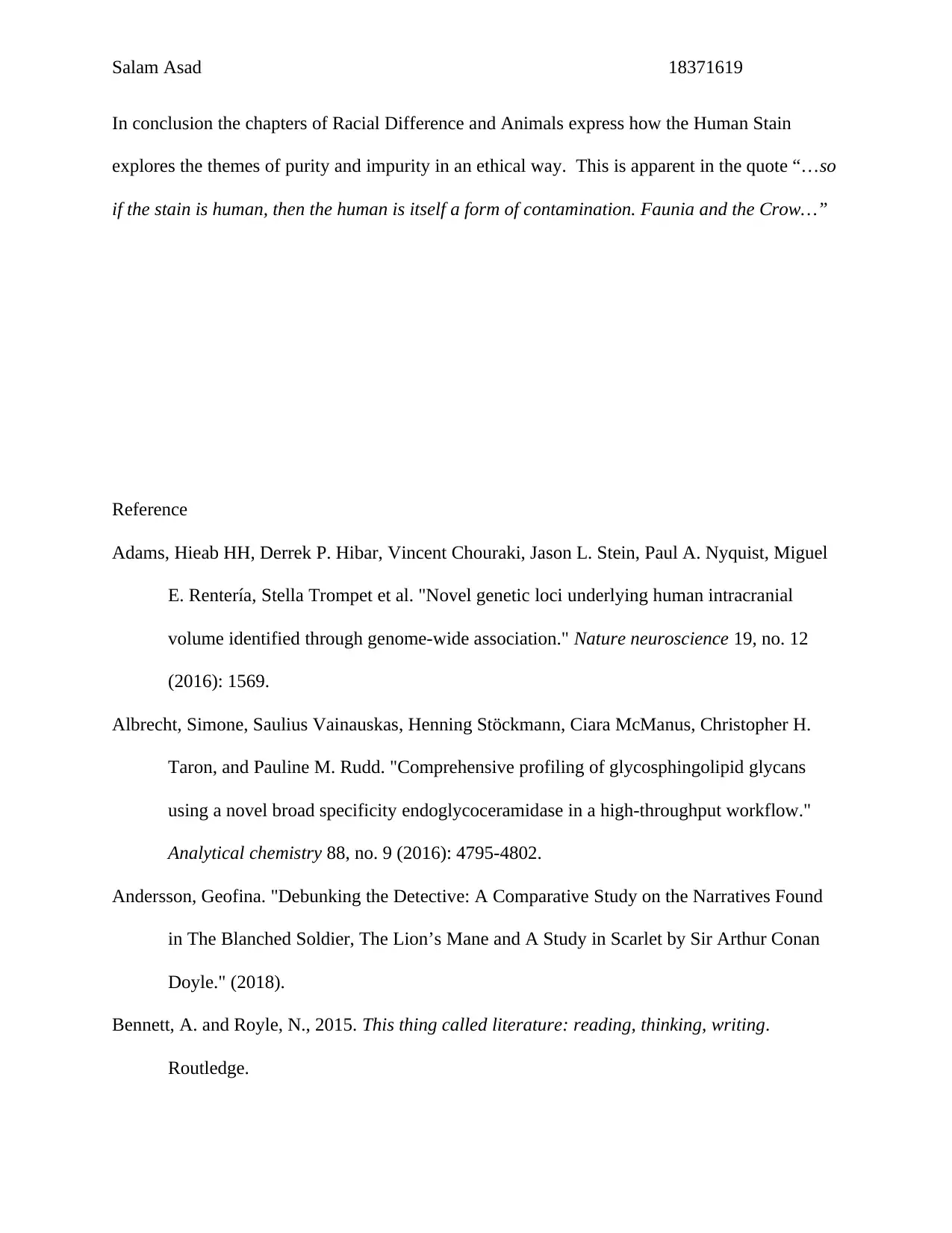
Salam Asad 18371619
In conclusion the chapters of Racial Difference and Animals express how the Human Stain
explores the themes of purity and impurity in an ethical way. This is apparent in the quote “…so
if the stain is human, then the human is itself a form of contamination. Faunia and the Crow…”
Reference
Adams, Hieab HH, Derrek P. Hibar, Vincent Chouraki, Jason L. Stein, Paul A. Nyquist, Miguel
E. Rentería, Stella Trompet et al. "Novel genetic loci underlying human intracranial
volume identified through genome-wide association." Nature neuroscience 19, no. 12
(2016): 1569.
Albrecht, Simone, Saulius Vainauskas, Henning Stöckmann, Ciara McManus, Christopher H.
Taron, and Pauline M. Rudd. "Comprehensive profiling of glycosphingolipid glycans
using a novel broad specificity endoglycoceramidase in a high-throughput workflow."
Analytical chemistry 88, no. 9 (2016): 4795-4802.
Andersson, Geofina. "Debunking the Detective: A Comparative Study on the Narratives Found
in The Blanched Soldier, The Lion’s Mane and A Study in Scarlet by Sir Arthur Conan
Doyle." (2018).
Bennett, A. and Royle, N., 2015. This thing called literature: reading, thinking, writing.
Routledge.
In conclusion the chapters of Racial Difference and Animals express how the Human Stain
explores the themes of purity and impurity in an ethical way. This is apparent in the quote “…so
if the stain is human, then the human is itself a form of contamination. Faunia and the Crow…”
Reference
Adams, Hieab HH, Derrek P. Hibar, Vincent Chouraki, Jason L. Stein, Paul A. Nyquist, Miguel
E. Rentería, Stella Trompet et al. "Novel genetic loci underlying human intracranial
volume identified through genome-wide association." Nature neuroscience 19, no. 12
(2016): 1569.
Albrecht, Simone, Saulius Vainauskas, Henning Stöckmann, Ciara McManus, Christopher H.
Taron, and Pauline M. Rudd. "Comprehensive profiling of glycosphingolipid glycans
using a novel broad specificity endoglycoceramidase in a high-throughput workflow."
Analytical chemistry 88, no. 9 (2016): 4795-4802.
Andersson, Geofina. "Debunking the Detective: A Comparative Study on the Narratives Found
in The Blanched Soldier, The Lion’s Mane and A Study in Scarlet by Sir Arthur Conan
Doyle." (2018).
Bennett, A. and Royle, N., 2015. This thing called literature: reading, thinking, writing.
Routledge.
Secure Best Marks with AI Grader
Need help grading? Try our AI Grader for instant feedback on your assignments.
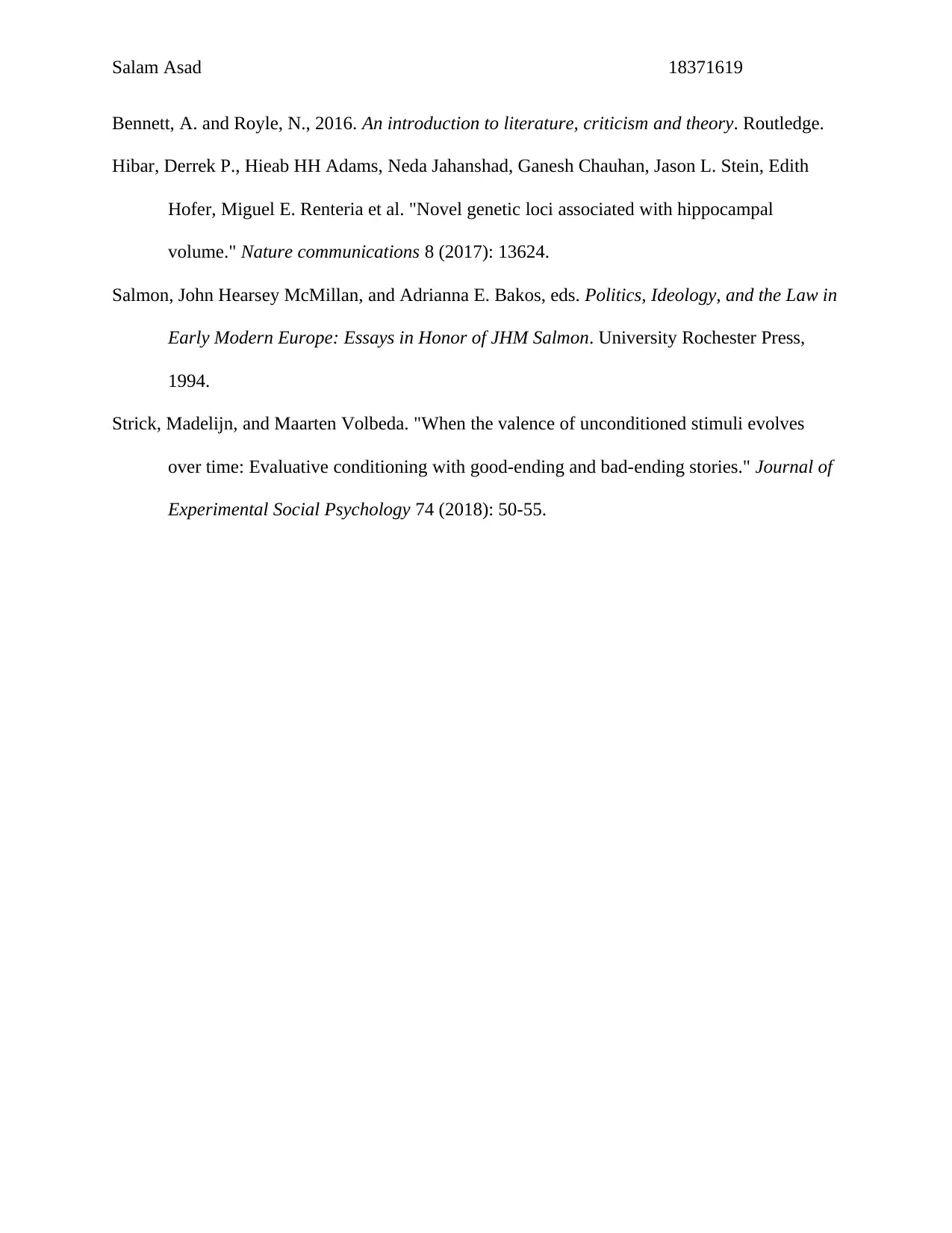
Salam Asad 18371619
Bennett, A. and Royle, N., 2016. An introduction to literature, criticism and theory. Routledge.
Hibar, Derrek P., Hieab HH Adams, Neda Jahanshad, Ganesh Chauhan, Jason L. Stein, Edith
Hofer, Miguel E. Renteria et al. "Novel genetic loci associated with hippocampal
volume." Nature communications 8 (2017): 13624.
Salmon, John Hearsey McMillan, and Adrianna E. Bakos, eds. Politics, Ideology, and the Law in
Early Modern Europe: Essays in Honor of JHM Salmon. University Rochester Press,
1994.
Strick, Madelijn, and Maarten Volbeda. "When the valence of unconditioned stimuli evolves
over time: Evaluative conditioning with good-ending and bad-ending stories." Journal of
Experimental Social Psychology 74 (2018): 50-55.
Bennett, A. and Royle, N., 2016. An introduction to literature, criticism and theory. Routledge.
Hibar, Derrek P., Hieab HH Adams, Neda Jahanshad, Ganesh Chauhan, Jason L. Stein, Edith
Hofer, Miguel E. Renteria et al. "Novel genetic loci associated with hippocampal
volume." Nature communications 8 (2017): 13624.
Salmon, John Hearsey McMillan, and Adrianna E. Bakos, eds. Politics, Ideology, and the Law in
Early Modern Europe: Essays in Honor of JHM Salmon. University Rochester Press,
1994.
Strick, Madelijn, and Maarten Volbeda. "When the valence of unconditioned stimuli evolves
over time: Evaluative conditioning with good-ending and bad-ending stories." Journal of
Experimental Social Psychology 74 (2018): 50-55.
1 out of 5
Your All-in-One AI-Powered Toolkit for Academic Success.
+13062052269
info@desklib.com
Available 24*7 on WhatsApp / Email
![[object Object]](/_next/static/media/star-bottom.7253800d.svg)
Unlock your academic potential
© 2024 | Zucol Services PVT LTD | All rights reserved.